Intel Xeon E5-2697 v2 and Xeon E5-2687W v2 Review: 12 and 8 Cores
by Ian Cutress on March 17, 2014 11:59 AM EST- Posted in
- CPUs
- Intel
- Xeon
- Enterprise
Real World CPU Benchmarks
Rendering – Adobe After Effects CS6: link
Published by Adobe, After Effects is a digital motion graphics, visual effects and compositing software package used in the post-production process of filmmaking and television production. For our benchmark we downloaded a common scene in use on the AE forums for benchmarks and placed it under our own circumstances for a repeatable benchmark. We generate 152 frames of the scene and present the time to do so based purely on CPU calculations.
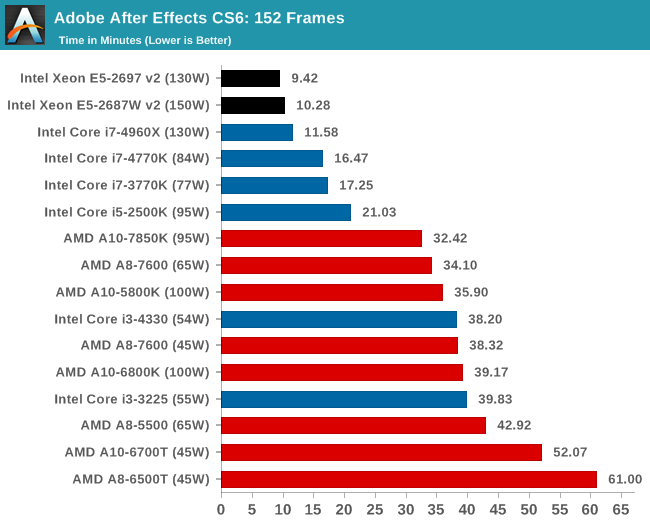
With AE6 being an optimized software package, more cores and threads rather than more MHz makes sense in our test.
Compression – WinRAR 5.0.1: link
Our WinRAR test from 2013 is updated to the latest version of WinRAR at the start of 2014. We compress a set of 2867 files across 320 folders totaling 1.52 GB in size – 95% of these files are small typical website files, and the rest (90% of the size) are small 30 second 720p videos.
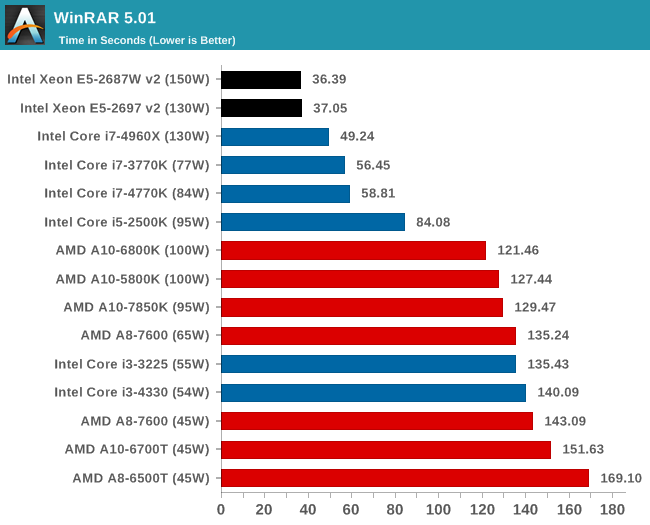
Due to the variable nature of the WinRAR test, our Xeons come out on top but it is hard to choose between them.
Image Manipulation – FastStone Image Viewer 4.9: link
Similarly to WinRAR, the FastStone test us updated for 2014 to the latest version. FastStone is the program I use to perform quick or bulk actions on images, such as resizing, adjusting for color and cropping. In our test we take a series of 170 images in various sizes and formats and convert them all into 640x480 .gif files, maintaining the aspect ratio. FastStone does not use multithreading for this test, and thus single threaded performance is often the winner.
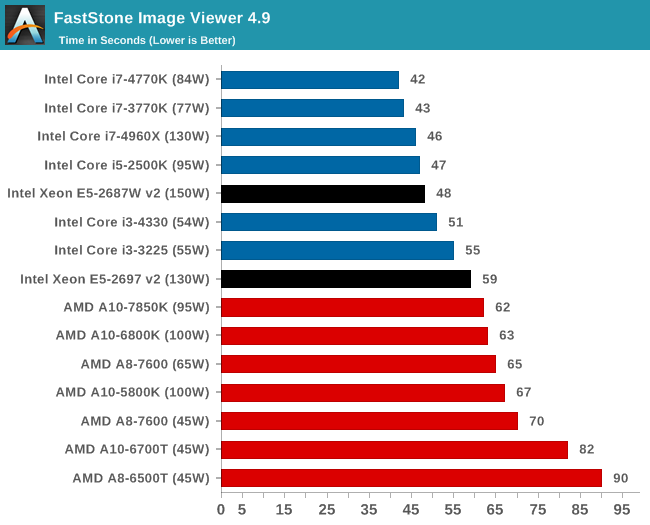
FastStone is a single threaded application where IPC and MHz matter. As a result, the newest architectures and platforms do better here than the Ivy Bridge-E based Xeons.
Video Conversion – Xilisoft Video Converter 7: link
The XVC test I normally do is updated to the full version of the software, and this time a different test as well. Here we take two different videos: a double UHD (3840x4320) clip of 10 minutes and a 640x266 DVD rip of a 2h20 film and convert both to iPod suitable formats. The reasoning here is simple – when frames are small enough to fit into memory, the algorithm has more chance to apply work between threads and process the video quicker. Results shown are in seconds and time taken to encode.

When going through lots of small frames, our XVC test working on one file prefers cores and threads over MHz.

When the workload has some room to grow with larger frames, segments of each frame can be dispatched to cores more approprately and the 12-core Xeon comes out on top.
Video Conversion – Handbrake v0.9.9: link
Handbrake is a media conversion tool that was initially designed to help DVD ISOs and Video CDs into more common video formats. The principle today is still the same, primarily as an output for H.264 + AAC/MP3 audio within an MKV container. In our test we use the same videos as in the Xilisoft test, and results are given in frames per second.
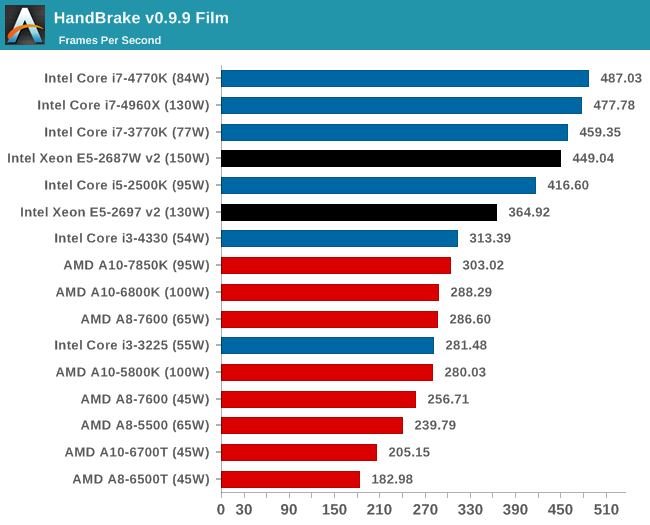
Similar to the XVC test, when the frames are small the software has to fight against thread dispatch of smaller pieces that get in the way of opening up the trottle.
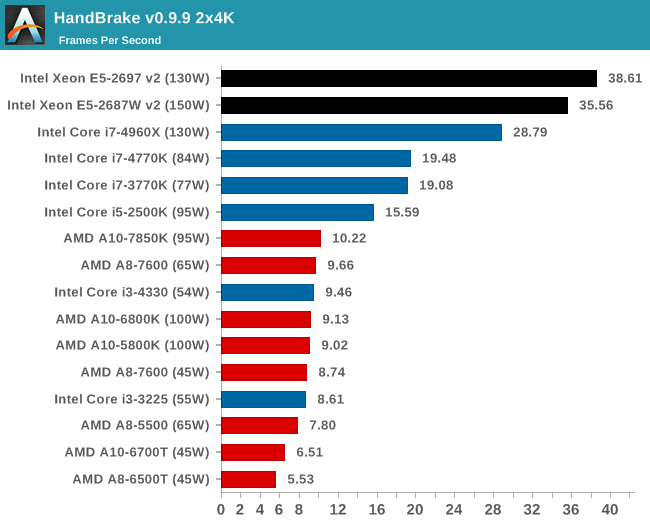
Move to larger frames again and the Xeons can use their full force. Cores over MHz wins here.
Rendering – PovRay 3.7: link
The Persistence of Vision RayTracer, or PovRay, is a freeware package for as the name suggests, ray tracing. It is a pure renderer, rather than modeling software, but the latest beta version contains a handy benchmark for stressing all processing threads on a platform. We have been using this test in motherboard reviews to test memory stability at various CPU speeds to good effect – if it passes the test, the IMC in the CPU is stable for a given CPU speed. As a CPU test, it runs for approximately 2-3 minutes on high end platforms.
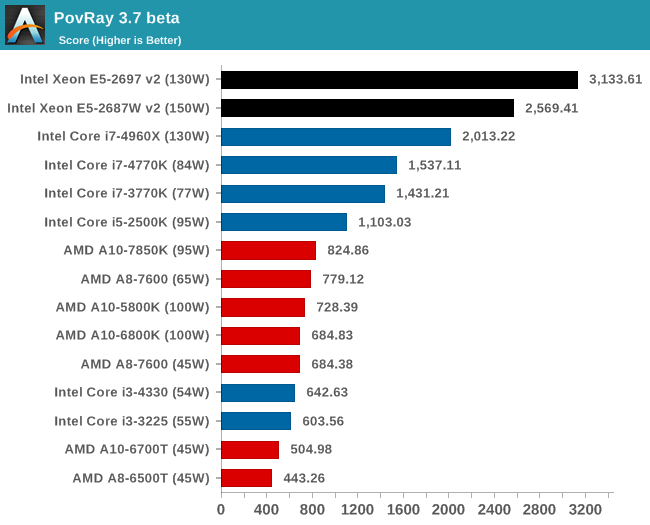
PovRay becomes an embarrassingly parallel benchmark where cores x frequency come out on top. This pattern of results is a common sight in our synthetic testing.










71 Comments
View All Comments
mrnuxi - Tuesday, March 18, 2014 - link
I know you were benchmarking these Xeons for home use, thus the selection of rendering and gaming benchmarks. But there are lots of us doing home virtualization (VMWare ESXi all-in-one servers using PCI-passthrough ZFS virtual SAN and multiple VMs). It would be great so see some virtualization benchmarks. For further reference see: http://www.napp-it.org/index_en.htmlIan Cutress - Tuesday, March 18, 2014 - link
Johan covered the server side in his article -http://www.anandtech.com/show/7285/intel-xeon-e5-2...
alpha754293 - Wednesday, March 19, 2014 - link
No LS-DYNA or other HPC benchmark results??? Talk to Johan.colonelclaw - Wednesday, March 19, 2014 - link
Hi Ian, Thanks for a great review.Do you think there's any possibility of adding V-Ray to your workstation benchmarks? It's an incredibly popular renderer that is multi-platform and also works in pretty much any decent 3D software (Max, Maya, C4D etc). It also sucks the life out of any computer when it's running, so would be perfect for your tests.
Kougar - Wednesday, March 19, 2014 - link
Question. Since you discuss turbo bins at length and the article revolves around them, how does Windows Server handle load balancing in regards to the turbo bins. On a 2P E5-2697 will the OS balance all the threads on a single CPU first? Spread evenly across both CPUs? Max out all physical cores before assigning threads to logical cores?Is the OS capable of spreading 3 threads to each processor to ensure they both run at the max turbo frequency for as long as possible? Or would it instead max out one processor to attempt to let the other retain a lower power state? For that matter is any of this even configurable under Windows Server?
Ytterbium - Saturday, May 3, 2014 - link
Ian, does MCE work with Xeon?Ytterbium - Tuesday, May 6, 2014 - link
MCE doesn't seem to work with Xeon 2687w.RadamanthysBe - Sunday, May 4, 2014 - link
Interresting article, but I dont agree with your conclusion on the 2667 vs 2687w :You say 2667 id cheaper, ok but 50 $ difference in list price on cpu costing 2100 $, that is less than 2%.
You also say 2687w v2 use more energy than 2667 v2, do you have proof of that ? For me the fact that 2687w v2 has a 150w tdp only mean it can keep its turbo frequency under higher load than 2667, with situations where 2667 turbo mode would drop because of the power usage while not on the 2687w v2, making it in fine a faster cpu than 2667 under heavy loads. If the two cpu run the same computation at the same frequency, there is no reason 2687w v2 uses more power, it would be like saying that i5 and i7 consume the same because they have the same tdp, while everybody knows it is not the case.
Ytterbium - Monday, May 5, 2014 - link
I just bought a 2687w v2, it ended up being $3 difference between them, I have i7-3970X so I have 150W chip anyway, so TDP wasn't really much of a factor to me.It would be interesting to do a head to head of them and see how they perform, in thermal load/power.
Following Ian's logic he's be super interested in the E5-2673 v2, this is the same as the 2667 but with 110W TDP.
If the 2690 had a little higher turbo, it would be great, 10/20 with say 3 stock and 3.8 turbo
Ytterbium - Tuesday, May 6, 2014 - link
The 2687 I got seems to run a bit cooler than my 3970X, even though there rated for the same.